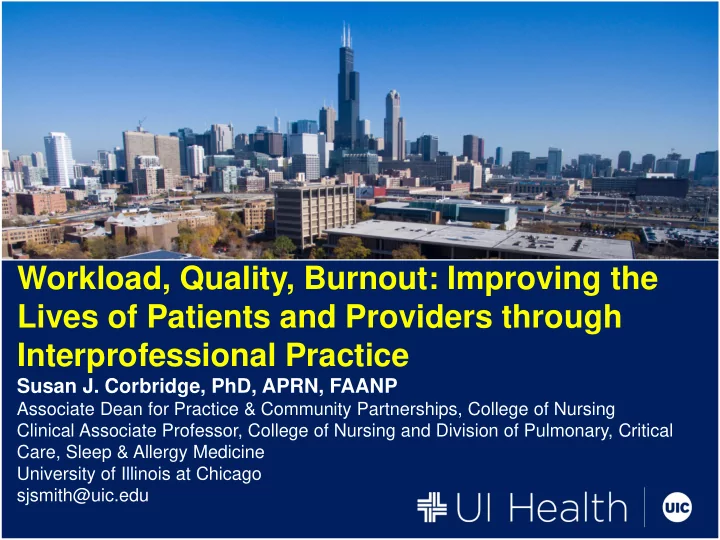

Workload, Quality, Burnout: Improving the Lives of Patients and Providers through Interprofessional Practice Susan J. Corbridge, PhD, APRN, FAANP Associate Dean for Practice & Community Partnerships, College of Nursing Clinical Associate Professor, College of Nursing and Division of Pulmonary, Critical Care, Sleep & Allergy Medicine University of Illinois at Chicago sjsmith@uic.edu
OBJECTIVES • Review the evidence of interprofessional teams on workload, burnout & quality of care. • Provide two examples from our institution of interprofessional team modeling. • Recommend strategies for implementing interprofessional team-based models.
WORKLOAD • Interprofessional teams decrease workload 1 • Interprofessional practice frees up time for other medical services (better use of one’s skillset) 1 • Shared knowledge of and investment in the patient 2 – Patients needing unscheduled visits, etc. – Patient with new problem; need for collaboration 1 Chomienne M-H et al. 2011. J of Eval in Clini Prac, 17; 282-287. 2 Sinsky et al. 2013. Annals of Fam Med. 11(3) 272 – 278.
BURNOUT • Increasing job satisfaction decreases burnout • Relationships are important at all career levels to increased job satisfaction 1 • Collegial relationships, learning from each other and development of mutual respect and trust increase satisfaction 1 • Sharing clinical care among a team & having a high functioning team improves professional satisfaction 2 1 Ahmed N et al. 2012. Acad Med. 87(11):1616-1621. 2 Sinsky et al. 2013. Annals of Fam Med. 11(3) 272 – 278.
QUALITY • Improved patient outcomes – Earlier diagnosis 1 – Patient quality-of-life scores improved 1 – Increased provider knowledge 1 – Patient satisfaction and willingness to work with other professionals entering in the practice (trust relationship) 1 – Decreased ICU mortality 2 – Decreased rates of ventilator-associated pneumonia 3 • “Seat at the table” by nurses; more “buy in” 1 Chomienne M-H et al. 2010. J of Eval in Clini Prac, 17; 282-287. 2 Kim M et al.2010. Arch Intern Med, Feb 22;170(4):369-76. 3 Costa D et al. 2016. Am J of Infection Control, 44(10), 1181-1183.
One Model of an Interprofessional, Team-based Sub-specialty Clinic
A Second Model of an Interprofessional, Team-based Primary Care Clinic (Federally Qualified Health Center): • Nurse Managed Clinic • Humboldt Park, Chicago’s West Side • One of Chicago’s most disadvantaged communities • Department of Corrections partnership • High need for primary care and mental health services
Collaborative Care Model PHQ-9 GAD-7 AUDIT-C DAST-10 Medical Assistant Primary Care Provider Patient Psychiatric Behavioral Health Consultant Care Manager
RECOMMENDED STRATEGIES • Individualize an approach to meet specific needs • Strive for a horizontal model • Recognize unique expertise of team members • Leverage diversity for stronger teams • Advocate top-of-license practice • Recognize billing and system constraints • Include administration when appropriate • Acknowledge that words matter • Partner with academic institutions • Address documentation requirements and malpractice through policy
ADDITIONAL REFERENCES • Corbridge, S., Tiffen, J., Carlucci, M., & Zar, F. (2013). Implementation of an Interprofessional Clinical Education Model. Nurse Educator, 38(6), 261-264. http://dx.doi.org/10.1097/01.NNE.0000435271.40151.23 • Archer J, Bower P, Gilbody S, Lovell K, Richards D, Gask L, Dickens C, Coventry P. (2012). Collaborative Care for People with Depression and Anxiety. Cochrane Review. http://doi: 10.1002/14651858.CD006525.pub2 • Institute for Healthcare Improvement (2018). http://www.ihi.org/ • Waljee, J., Chopra V., & Saint S. (2018). Mentoring Millennials. Journal of the American Medical Association. Apr 17;319(15):1547- 1548
Recommend
More recommend